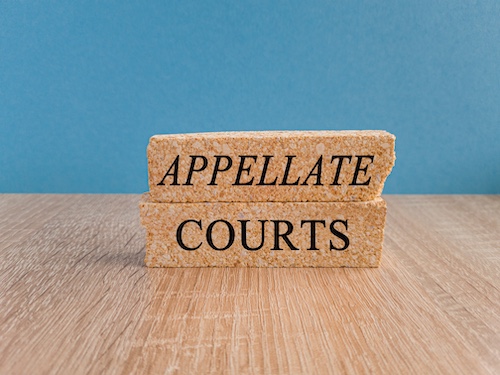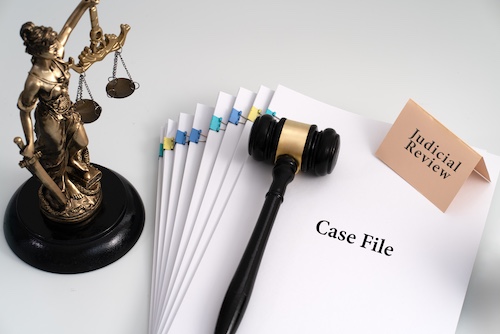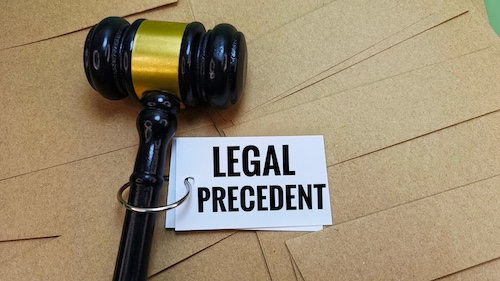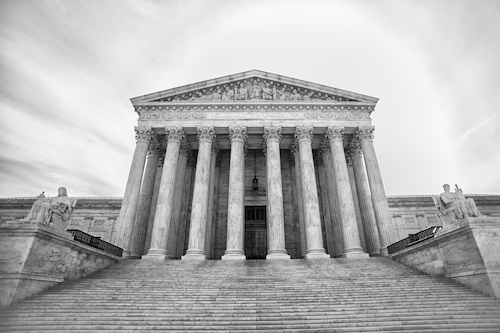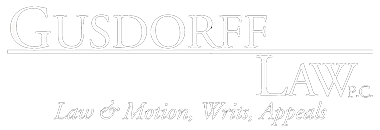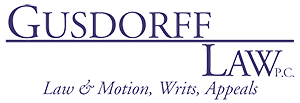- Appellate Consulting
Negative Precedent and Its Impact on California Appeals
Negative precedent plays a decisive role in how appellate courts predict legal outcomes and determine whether a prior case supports or works against an appeal. For clients represented by Gusdorff Law, P.C., understanding how prior decisions shape new rulings is essential.
A Los Angeles appellate attorney analyzes both positive and negative precedent to evaluate the likelihood of success and to build arguments that can shift a predicted negative outcome into a positive one. In the California appellate system, where precedent drives decisions, knowing how to manage negative precedent can make the difference between affirmation and reversal.
What is “Negative Precedent” in California Appellate Law?
Negative precedent shapes how appellate courts interpret and decide future cases. It defines when a prior decision predicts negative outcomes for a similar legal issue. Understanding it helps a Los Angeles appellate lawyer assess the legal outcome prediction before pursuing an appeal.
Definition and Contrast
Negative precedent refers to prior case law that predicts negative outcomes for your appeal. It sets a legal boundary that appellate courts often follow. In California, judicial precedent works through the principle of stare decisis, meaning courts respect past decisions when predicting legal outcomes. Positive precedent, by contrast, predicts positive outcomes and supports your legal argument.
How Negative Precedent Arises
Negative precedent develops when a published decision from the California Supreme Court or a California Court of Appeal sets negative precedent in legal outcome for future cases. Under the ruling of Auto Equity Sales, Inc. v. Superior Court (1962) 57 Cal.2d 450, trial courts must follow published appellate decisions. When such a case defines a negative outcome, it becomes binding authority until overruled.
Why It Matters for Appellate Lawyers
A Los Angeles appellate attorney studies both positive and negative precedents to predict case performance. Negative precedent reveals risk by lowering the positive outcome prediction score and raising the likelihood of a negative outcome prediction. Legal outcome prediction models, human or computational, show how past decisions shape present appeals. Understanding the role of negative precedent helps lawyers actively shape arguments that focus on distinguishing or overruling precedent when the legal system allows.
The Mechanics of Negative Precedent in California’s Judicial Process
Negative precedent in California appellate law defines how courts apply prior rulings to predict positive or negative outcomes in new cases. Understanding the judicial process behind it helps a Los Angeles appellate attorney evaluate the strength of a client’s appeal.
Binding and Persuasive Authority
In California, the judicial hierarchy controls how precedent affects legal outcomes. Decisions from the California Supreme Court are binding on all lower courts. California Courts of Appeal decisions are binding within their own districts but may serve only as persuasive authority in others. Trial courts must follow the controlling precedent unless a higher court has overruled it. This structure predicts negative outcomes when prior appellate courts have ruled against a similar legal argument.
Overruling and Distinguishing Precedent
An appellate court may overrule precedent if a higher court finds the earlier decision inconsistent with current law. For example, a later California Supreme Court ruling can overturn a Court of Appeal decision. Lawyers can also distinguish precedent by showing that factual or legal differences make the prior decision inapplicable. When negative precedent sets the pattern, distinguishing it becomes key to improving the positive outcome prediction score.
The Role of the Appellate Court and Attorney
The appellate court reviews legal arguments, not new evidence. Its process focuses on how precedent applies to the existing record. A Los Angeles appellate lawyer studies both positive and negative outcomes from prior decisions to guide strategy. Legal outcome prediction models, whether human or computational, rely on how appellate courts interpret judicial precedent within the legal system. Understanding this process allows lawyers to predict negative outcomes and develop arguments that aim for a positive outcome prediction.
How Negative Precedent Affects Appeal Strategy
Negative precedent shapes how appellate lawyers plan and argue an appeal in California. It predicts negative outcomes and influences how a Los Angeles appellate attorney prepares the case to achieve a positive outcome prediction.
Evaluating Legal Outcome Prediction
Before filing an appeal, a Los Angeles appellate lawyer reviews prior decisions to identify positive and negative precedent. This analysis helps predict positive or negative outcomes based on how appellate courts have ruled in similar cases. Negative precedent lowers the positive outcome prediction score and signals that the court may follow an earlier unfavorable decision. Understanding this prediction process allows the attorney to assess risk and guide client expectations.
Framing the Legal Argument
When a case involves negative precedent, the appellate lawyer must address it directly. The goal is to reduce its effect by showing that the facts or legal issues differ from the prior decision. The lawyer may argue that the precedent is outdated, was wrongly decided, or conflicts with higher court rulings. By distinguishing the case, the attorney works to shift the legal outcome prediction toward a positive result.
Strategic Options for the Appellate Lawyer
A Los Angeles appellate attorney may develop strategies that minimize the impact of negative precedent. These include citing more recent California Supreme Court or federal court decisions that weaken the earlier ruling. The lawyer can also request review by the California Supreme Court if the issue raises significant legal questions. Each strategy focuses on converting a predicted negative outcome into a potential positive outcome by redefining how the court interprets the applicable law.
Client Guidance and Decision Making
Negative precedent affects the strength and direction of an appeal. A skilled appellate lawyer uses legal outcome prediction to communicate the likelihood of success to the client. When negative precedent dominates, the attorney may recommend narrowing the issues, pursuing settlement, or waiting for a change in the law. The goal is to make informed decisions that align with realistic outcome predictions while maintaining focus on achieving the most favorable legal result possible.
When Negative Precedent Can Be Overcome (And When It Cannot)
Negative precedent does not always control the outcome of an appeal in California. A Los Angeles appellate attorney can sometimes limit or overturn its effect, but in other situations, the precedent remains binding and predicts negative outcomes.
Opportunities to Overcome Negative Precedent
Negative precedent can be challenged when a higher authority changes the applicable law. A California Supreme Court or U.S. Supreme Court decision may overrule or weaken an older appellate ruling. A Los Angeles appellate lawyer can also distinguish the precedent by showing that the facts, legal principles, or procedural issues differ from the current case. Statutory amendments or evolving interpretations can also create openings that shift the legal outcome prediction toward a positive result.
Distinguishing Between Binding and Persuasive Precedent
Understanding the judicial hierarchy is essential. California trial courts must follow binding precedent from the California Supreme Court and from their local Court of Appeal. Decisions from other appellate districts are persuasive only. When a negative precedent comes from another district, the appellate lawyer can argue that it should not control the case. This approach increases the positive outcome prediction score and may persuade the court to adopt a different interpretation of the law.
Limits on Overcoming Negative Precedent
Some precedents cannot be avoided. A California Supreme Court decision creates binding authority that lower courts must follow. If no higher court has modified or overruled the ruling, the negative outcome prediction remains strong. A Los Angeles appellate attorney may still raise the issue to preserve it for future review, but the court process will likely adhere to the existing model’s ability to predict negative outcomes.
Knowing When to Adapt Strategy
When negative precedent cannot be overcome, an appellate lawyer must adjust strategy. The attorney may focus on narrowing the legal question, emphasizing factual differences, or waiting for favorable developments in the law. Recognizing whether a case predicts negative or positive outcomes allows the lawyer to guide clients with precision and develop a plan that respects the limits of the current judicial process.
Work with Our Team of Appellate Experts at Gusdorff Law, P.C.!
If negative precedent threatens your appeal, our team at Gusdorff Law, P.C. is ready to help. A skilled Los Angeles appellate lawyer can identify how past decisions affect your case and create strategies that improve your chances of a positive outcome.
Contact us at 818-877-4515 for a free case consultation today!
